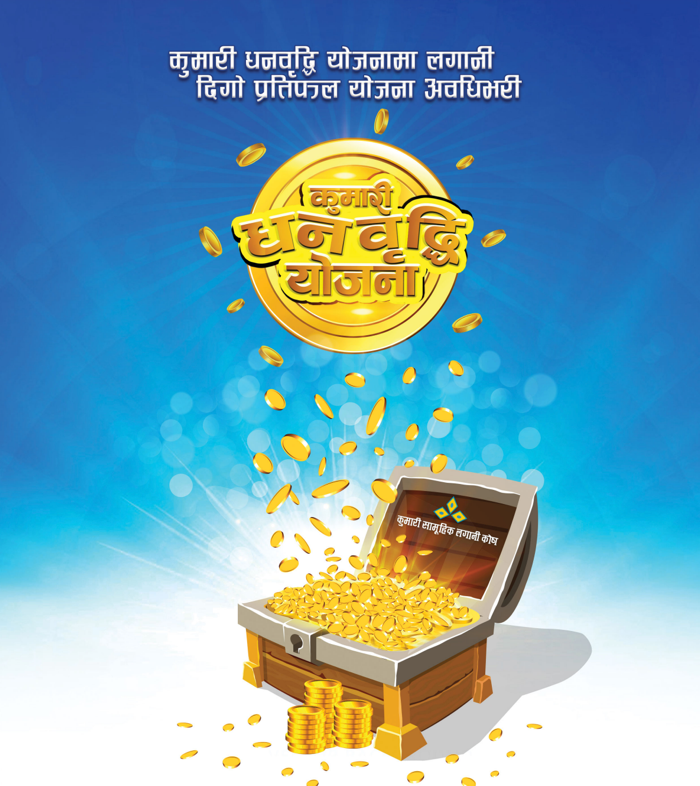Kumari Dhanabriddhi Yojana Scheme Opens From Jestha 12; All information You Need To Know In One Place
Company Profile
The mutual fund scheme “Kumari Dhanabriddhi Yojana” is promoted by Kumari Bank Limited and managed by Kumari Capital Limited.

Kumari Bank Limited (KBL) - KBL was established as Nepal's fifteenth commercial bank on Chaitra 21, 2057 B.S (April 3, 2001), with the goal of offering competitive modern banking services in the Nepalese financial market. The bank has NPR 14.71 billion in paid-up capital.
The Bank's branch network reached 197 branches, and 177 ATMs, Bank's loan investment to NPR 155 billion and deposit-base to NPR 165 billion.
Kumari Capital Limited (KCL) - Incorporated in October of 2017 under the Companies Act, 2007, KCL is a wholly-owned subsidiary of Kumari Bank Limited. At present, KCL is involved in fund management, issue management, underwriting, share registration, private placement, financial advisory services, and depository participation.
Kumari Capital has an MF depository licence as well as a fund manager licence from SEBON (as per the Mutual Fund Regulation, 2010) and plans to act in both capacities for its proposed closed-ended Mutual Fund scheme. The company reported a profit of NPR 10 million in FY2020 (100% YoY growth) on an asset base of NPR 216 million as of mid-July 2020.
About the issue
Kumari Capital Limited sets to open a new closed-end mutual fund scheme “Kumari Dhanabriddhi Yojana” worth Rs 1.2 arba with a maturity of 10 years. The corpus may be extended to 1.5 arba if the scheme is oversubscribed.
The opening date of this fund is on Jestha 12, 2079 and the closing date is on Jestha 17, 2076 at the earliest. If the application is not adequately subscribed the closing date will be extended up to Jestha 26, 2079.
The issue will be of 12,00,00,000 units worth Rs 1.2 arba and per unit, the cost is Rs 10. An investor can apply for a minimum of 100 units and a maximum of 1.2 crore units.
Allocation of the Funds
.png)
This mutual fund scheme is funded through listed securities, primary issues, fixed income securities and cash in the ratio of 57:3:35:5 as shown in the above diagram.
85% of the total issue i.e. 10.20 crore units will be open for the general public the and remaining 15% i.e 1.8 crore units will be kept as seed capital for sponsor Kumari Bank Limited and fund manager Kumari Capital Limited.
Projected NAV of “Kumari Dhanabriddhi Yojana” for 10 years
.png)
This is the second mutual fund managed by Kumari Capital Limited. Currently, there is another scheme named Kumari Equity Fund (KEF).
This scheme is closely supervised by;
- Surya Prasad Koirala
- Bharat Raj Pokharel
- Krishna Prasad Gyawali
- Nawaraj Burlakoti
- Prajit Kumar Timilsina.
The current chairman of Kumari Capital is Mr. Bikas Khanal, followed by Mr. Rohit Singh, Mr. Anil Joshi, and Mr. Hari Prasad Wagle as the directors of the company.
How to Apply for This Scheme?
The applicant can apply for this scheme from the online portal of CDSC - Mero Share starting from Jestha 12, 2079. The applicant must have DEMAT a/c before applying for this scheme. The minimum units to be applied is 100 and the price per unit is Rs. 10.
ICRA Rating of Kumari Capital
ICRA Nepal has reaffirmed the [ICRANP] AMC Quality 3 (AMC 3) fund management quality rating (FMQR) assigned to Kumari Capital Limited (KCL), indicating adequate assurance of the fund management quality.
Strengths and opportunities
- Strong ownership profile
- Experienced fund supervisors and management team.
- Regulatory changes led to improved banking sector liquidity and a sharp market upswing
Weaknesses and threats
- Developing stage of the mutual fund industry
- Limited investment diversification avenues
- Low attraction of MF schemes among general investors
Achievements of Kumari Equity Fund
Kumari Equity Fund (KEF) is a closed-end mutual fund scheme, having a fund size worth Rs. 1 Arba. This scheme was issued on 14th Fagun. 2077, having a maturity period of 10 years.
For FY 77/78, this scheme generated a 5% dividend payout in just 4 months of its inception. The NAV stood at 10.72 for FY 77/78.
.png)
The chart shows that there are fewer decline in NAV of the KEF compared to fell in the NEPSE index. This means that the investors have incurred less loss if they have invested in KEF during the review periods and it also incorporate that mutual funds are a safer investment.




